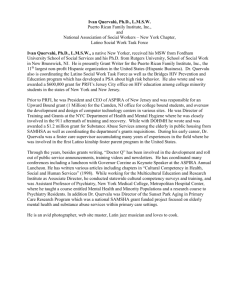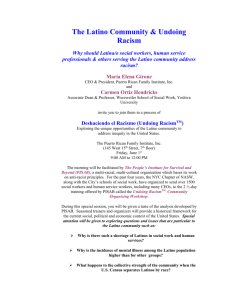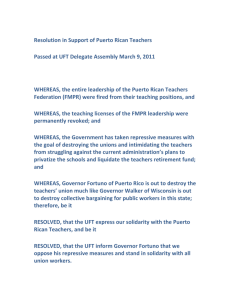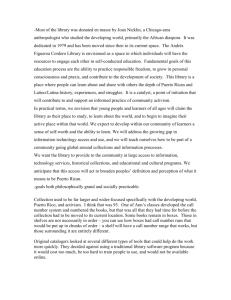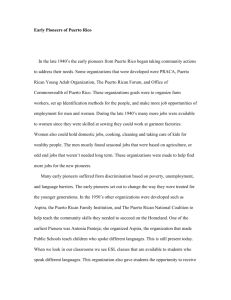CollegeReadinessPR-LatinoStudentsBibliography
advertisement
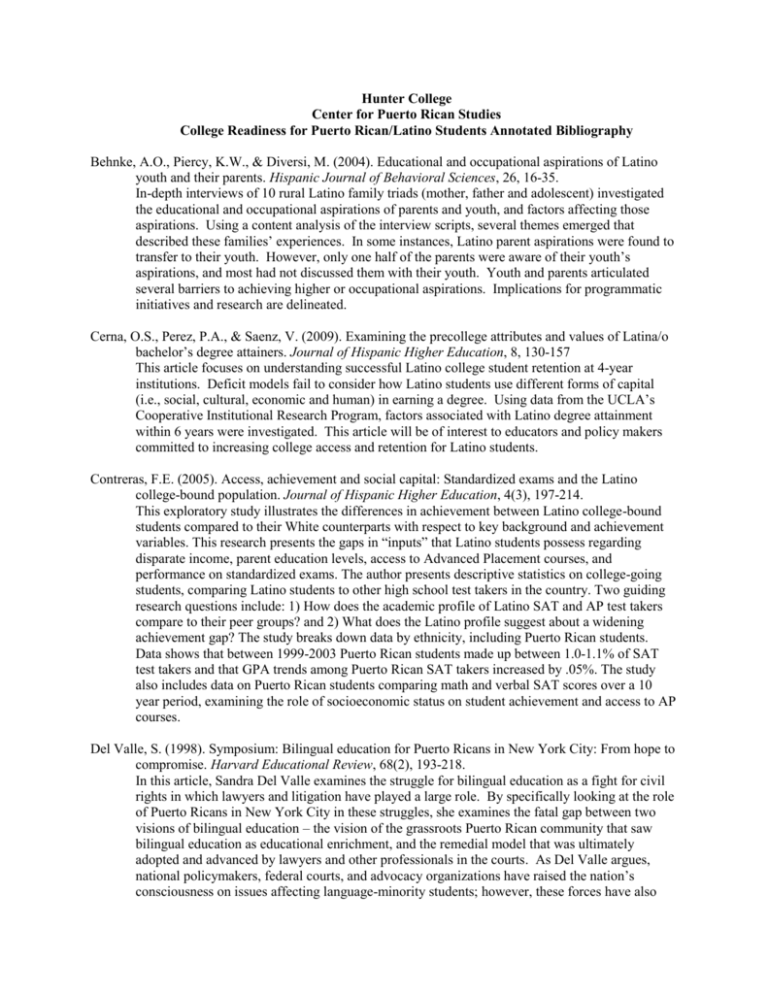
Hunter College Center for Puerto Rican Studies College Readiness for Puerto Rican/Latino Students Annotated Bibliography Behnke, A.O., Piercy, K.W., & Diversi, M. (2004). Educational and occupational aspirations of Latino youth and their parents. Hispanic Journal of Behavioral Sciences, 26, 16-35. In-depth interviews of 10 rural Latino family triads (mother, father and adolescent) investigated the educational and occupational aspirations of parents and youth, and factors affecting those aspirations. Using a content analysis of the interview scripts, several themes emerged that described these families’ experiences. In some instances, Latino parent aspirations were found to transfer to their youth. However, only one half of the parents were aware of their youth’s aspirations, and most had not discussed them with their youth. Youth and parents articulated several barriers to achieving higher or occupational aspirations. Implications for programmatic initiatives and research are delineated. Cerna, O.S., Perez, P.A., & Saenz, V. (2009). Examining the precollege attributes and values of Latina/o bachelor’s degree attainers. Journal of Hispanic Higher Education, 8, 130-157 This article focuses on understanding successful Latino college student retention at 4-year institutions. Deficit models fail to consider how Latino students use different forms of capital (i.e., social, cultural, economic and human) in earning a degree. Using data from the UCLA’s Cooperative Institutional Research Program, factors associated with Latino degree attainment within 6 years were investigated. This article will be of interest to educators and policy makers committed to increasing college access and retention for Latino students. Contreras, F.E. (2005). Access, achievement and social capital: Standardized exams and the Latino college-bound population. Journal of Hispanic Higher Education, 4(3), 197-214. This exploratory study illustrates the differences in achievement between Latino college-bound students compared to their White counterparts with respect to key background and achievement variables. This research presents the gaps in “inputs” that Latino students possess regarding disparate income, parent education levels, access to Advanced Placement courses, and performance on standardized exams. The author presents descriptive statistics on college-going students, comparing Latino students to other high school test takers in the country. Two guiding research questions include: 1) How does the academic profile of Latino SAT and AP test takers compare to their peer groups? and 2) What does the Latino profile suggest about a widening achievement gap? The study breaks down data by ethnicity, including Puerto Rican students. Data shows that between 1999-2003 Puerto Rican students made up between 1.0-1.1% of SAT test takers and that GPA trends among Puerto Rican SAT takers increased by .05%. The study also includes data on Puerto Rican students comparing math and verbal SAT scores over a 10 year period, examining the role of socioeconomic status on student achievement and access to AP courses. Del Valle, S. (1998). Symposium: Bilingual education for Puerto Ricans in New York City: From hope to compromise. Harvard Educational Review, 68(2), 193-218. In this article, Sandra Del Valle examines the struggle for bilingual education as a fight for civil rights in which lawyers and litigation have played a large role. By specifically looking at the role of Puerto Ricans in New York City in these struggles, she examines the fatal gap between two visions of bilingual education – the vision of the grassroots Puerto Rican community that saw bilingual education as educational enrichment, and the remedial model that was ultimately adopted and advanced by lawyers and other professionals in the courts. As Del Valle argues, national policymakers, federal courts, and advocacy organizations have raised the nation’s consciousness on issues affecting language-minority students; however, these forces have also contributed to the compromised nature of bilingual education, making it especially vulnerable to attack. Therefore, the role of these entities – that is, education advocates, policymakers, and the courts – must be constructed differently and take its cues from students, parents and local grassroots organizations. Flores, S.M. (2010). Assessing the higher education opportunity structure for Latino students: Research and policy trends at the turn of the century. In E.G. Murillo Jr. (Ed.), Handbook of Latinos and education: Theory, research and practice (pp. 210-218). New York and London: Routledge. This article examines how public policy trends have influenced the opportunity structure of higher education for Latinos. The article describes the growing prominence of Latinos in the higher education opportunity structure and offers a policy prognosis and an assessment of primary issues regarding the educational attainment of Latinos. The article argues that a continuous assessment of challenges, opportunities and successes will be essential to the progress of Latino students. Flores, R.J.O. (2002). An examination of neighborhood effects on patterns of high school attrition among Puerto Rican youth in the New York metropolitan area. Journal of Hispanic Higher Education, 1, 69-87. This study examines the effects of spatial concentration of Puerto Ricans on the likelihood of high school attrition among Puerto Rican adolescents. Using data from the 1990 U.S. Census of Population and Housing, the authors find that neighborhoods with very high concentrations of Puerto Ricans did significantly increase the risk of high school attrition among adolescent Puerto Ricans regardless of family background and other relevant characteristics. They also find important differences by gender. Gándara, P., & Contreras, F. (2009). The Latino education crisis. Cambridge, MA: Harvard University Press. Drawing on both extensive demographic data and compelling case studies, this book reveals the depth of the education crisis looming for Latinos, the nation’s largest and most rapidly growing minority group. The book describes the cumulative disadvantages that too many children face in the complex American school systems, where one in five students is Latino. Many live in poor and dangerous neighborhoods, attend impoverished and underachieving schools, and are raised by parents who speak little English and are the least educated in any ethnic group. The effects for the families, the community and the nation are sobering. Latino children are behind on academic measures by the time they enter kindergarten. And although the immigrant drive propels some to success, most never catch up. Many drop out of high school; those who do go onto college—often ill-prepared and overworked—seldom finish. Chapter 6 provides data for the two largest Latino subgroups, Puerto Ricans and Mexicans. The data specifically focuses on SAT score profiles, the relationships between social class and SAT test scores, mother’s education level and SAT scores and parent income levels and SAT scores. Haro, R. (2004). Programs and strategies to increase Latino students’ educational attainment. Education and Urban Society, 36, 205-222. This article presents strategies that Latino parents and Latino students need to know regarding preparing for and selecting the best undergraduate college or university for the career desired, especially if the choice involves engineering, mathematics or the sciences. Access to pertinent information on preparation for admission to a college or a university of choice, and then how to negotiate the system to graduate in a timely manner with high grades, is discussed. Sources for advice on going to college can be located at community centers, public libraries, schools, and especially outreach programs and the internet. Moreover, the role of faculty and of academicguidance personnel on most good campuses that are able to assist students to make informed decisions about career plans is provided. Whether a Latino student succeeds in going to graduate school involves having correct information, interacting and mentoring with supportive faculty, learning to use a computer with Internet capabilities, and completing a rigorous academic program. Harris, A.L., Jamison, K.M., & Trujillo, M.H. (2008). Disparities in the educational success of immigrants: An assessment of the immigrant effect for Asians and Latinos. The ANNALS of the American Academy of Political and Social Science, 620, 90-114. This study employs nationally representative data to determine how immigrants from the largest immigrant groups within the United States (i.e., Asians and Latinos) compare to whites on wide range of educational outcomes. The authors also examine the extent to which socioeconomic background and immigrant characteristics explain racial/ethnic difference in academic outcomes. In addition, this study includes analyses that omit whites and compare immigrants to their nonimmigrant counterparts. Previous studies typically use whites as a basis for comparison, which the authors argue may not be appropriate for isolating the immigrant effect on scholastic outcomes. Findings show Asian immigrants have better educational outcomes than whites, which is accounted for by their immigrant characteristics. In contrast, Mexican and Puerto Rican immigrants have lower educational outcomes than whites, most of which is explained by socioeconomic background. Furthermore, findings illustrate the importance of employing the proper reference group for immigration scholars. Irizarry, J.G. & Nieto, S. (2010). Latino/a theoretical contributions to educational praxis: Abriendo caminos, construyendo puentes. In E.G. Murillo Jr. (Ed.), Handbook of Latinos and education: Theory, research and practice (pp. 108-123). New York and London: Routledge. This article synthesizes research engaged in educational praxis that has made important contributions to the field of Latino education, examines commonalities and distinct features of this scholarship and discusses implications of this research to positively transform the educational trajectories of Latino students. The article provides a sociohistorical perspective on the traditional educational research literature on Latino students that has focused on individuals’ supposed cultural deficiencies and uses the English-only curriculum imposed in Puerto Rico during the early 20th century as a historical example. In examining research grounded in and informed by Latino communities, the article cites research that explores the relationship between race/ethnicity and caring in the educational experience of a group of Puerto Rican students. Medina, C.L. (2003). Puerto Rican subjective locations. Definitions and perceptions of literacy. Journal of Hispanic Higher Education, 2(4), 392-405. This manuscript addresses the epistemological shift from traditional “objective” and “neutral” forms of perceiving literacy to more complex and subjective perceptions, allowing for traditionally marginalized narratives to become an active part of the dialogue within the field of literacy. It critically examines how the author’s definitions of literacy in her scholarly work are shaped by and grow out of her own identity—a Puerto Rican bilingual woman who navigates between the mainland and the island. Mercado, C.I., & Reyes, L.O. (2010). Latino community activism in the twenty-first century: Confronting the future, learning from the past. In E.G. Murillo Jr. (Ed.), Handbook of Latinos and education: Theory, research and practice (pp. 250-261). New York and London: Routledge. This article is about community activism that seeks to affect change in public school policy with the goal of improving the education of Latino students in the U.S. schools. The goals and purposes of Latino community activism have changed over time as U.S. communities grapple with demographic change and changing dynamics of geographical, political, social and economic forces that shape and influence all facets of life. The article advocates for a re-conceptualization of Latino activism as a collective project that demands new alliances and the use of local resources and technological tools in new ways and in diverse social arenas. Some questions that the article addresses include: How should Latino community activism be conceptualized for the 21st century? and What lessons have been learned from the past that may guide what we do in the future? The article frames the issues from the perspectives and experiences of Mexicans/Chicanos and Puerto Ricans/Boricuas. In addressing lessons from the past within the Puerto Rican community, the article notes the legacy of activism and the emergence of a Puerto Rican consciousness or group solidarity in the diasporic community. The article explores local cases of Puerto Rican educational activism in New York City and organizational commitment to the cultural self-affirmation of the Puerto Rican community, as expressed in organizations such as Aspira of New York, the Puerto Rican Community Development Project, the Puerto Rican Forum, and Universidad Boricua. Nieto, S. (1998). Symposium: Fact and fiction: Stories of Puerto Ricans in U.S. schools. Harvard Educational Review, 68(2): 133-164. Puerto Rican communities have been a reality in many northeastern urban centers for over a century. Schools and classrooms have felt their presence through the Puerto Rican students attending school. The education of Puerto Ricans in U.S. schools has been documented for about seventy years, but in spite of numerous commissions, research reports, and other studies, this history is largely unknown to teachers and the general public. In addition to the research literature, a growing number of fictional accounts in English are providing another fertile avenue for understanding the challenges that Puerto Ricans have faced, and continue to face, in U.S. schools. In this article, Sonia Nieto combines the research on Puerto Rican students in U.S schools with the power of the growing body of fiction written by Puerto Ricans. In this weaving of “fact” and “fiction,” Nieto hopes to provide a more comprehensive and more human portrait of Puerto Rican students. Based on her reading of the literature in both educational research and fiction, Nieto suggests four interrelated and contrasting themes that have emerged from the long history of stories told about Puerto Ricans in U.S. schools: colonialism/resistance, cultural deficit/cultural acceptance, assimilation/identity, and marginalization/belonging. Nieto’s analysis of these four themes then leads her to a discussion of the issue of care as the missing ingredient in the education of Puerto Ricans in the United States. Nieto, S. (Senior Editor), Rivera, M. & Quiñones, S. (Editors). (2010). Charting a new course: Understanding the sociocultural, political, economic, and historical context of Latino/a education in the United States. New York, NY: Center for Puerto Rican Studies. This document is a product of the National Latino Education Research and Policy Project (NLERAP), a national initiative begun in 2000 by the Center for Puerto Rican Studies at Hunter College and now sited at the University of Texas Center for Educational Policy. The monograph provides a critical synthesis of the literature in understanding the context of Latino education at the interpersonal, instructional, and institutional levels. This publication is intended for both professional and scholarly audiences and is a useful tool for researchers, practitioners, advocates and administrators undertaking efforts relating to the improvement of education for Latino students in their local areas. Based on their review of promising practices and creative projects as well as their critical synthesis of the literature, NLERAP addresses positive future directions in the broad areas of teacher preparation for diversity, services for ELL and immigrant students, family outreach and community engagement, and school, state and federal policies and practices. Perry, W. (1998). Symposium: Memorias de una vida de obra (memories of a life of work): An interview with Antonia Pantoja. Harvard Educational Review, 68(2): 244-259. Antonia Pantoja is an important activist and educator in the Puerto Rican community, both on the Island and in the United States. Pantoja was interviewed for the Harvard Educational Review by Wilhelmina Perry, and African American educator who has known Pantoja for the last twenty years as a colleague, friend, and coworker. This interview is part of a dialogue around the significant issues of Pantoja’s life that reflects her life’s work resisting the colonization of the Puerto Rican community. Through Pantoja’s memories we are provided with the early and personal experiences that shaped her political and social commitments in her struggle against injustice. Pantoja’s contribution to this Symposium brings in a unique voice of a Puerto Rican woman committed to her people. Rochin, R.I., & Mello, S.F. (2007). Latinos in science: Trends and opportunities. Journal of Hispanic Higher Education, 6, 305-355. DOI: 10.1177/1538192707306552. In United States coverage of leadership in science and engineering (S&E), Latinos are generally dismissed from consideration. The pipeline metaphor tends to ignore advances made by Latinos in completing doctoral degrees in S&E. New data suggest a better metaphor, the pyramid of higher education, for understanding the progress of Latinos in S&E. Questions addressed include, what fields are pursued? What is the citizenship of Latino doctorates? What are the baccalaureate origins of Latino doctorates? What roles do community colleges and Hispanicserving institutions play in serving Latinos? Specifically, this article mentions that, after Mexican-Americans, Puerto Ricans are the most numerous Latino group, and that many Latinos receive their S&E doctorates in Puerto Rican universities. Rodriguez, G.M., & Cruz, L. (2009). The transition to college of English learner and undocumented immigrant students: Resource and policy implications. Teachers College Record, 111(10), 23852418. Although the historical context and contemporary issues associated with English learners (ELs) and undocumented immigrant students are in many ways distinct, the project team strongly believed that the college transition issues affecting these populations were increasingly salient in light of their rapid and continued growth throughout the United States. The research questions guiding this analysis are: (1) What do we know and what do we need to know about the transition to college of EL and undocumented immigrant students? and (2) What are the resource and policy implications associated with the transition to college of these students? The chief purpose of this analysis is to synthesize the current research and thinking about the transitions to college of EL and undocumented immigrant students and to use the findings to develop a research agenda focused on emergent critical issues. There is continued growth in the presence of EL and undocumented students, and this growth affects states with longstanding histories of immigrant presence, as well as states that have only recently had notable increases in these populations. Important to understanding the needs and potential of these two groups is that not all EL and undocumented students are new immigrants. Rather, many have only experienced education in the United States, having been born here or having arrived at a very young age with their families. From this analysis, it appears that English proficiency is as much a gatekeeping factor as it is a facilitative factor for EL and undocumented students in their successful college transitions. Unfortunately, because of the impact of poverty on these populations, the financial constraints of transitioning to college further compound the challenges already faced with regard to acquiring English and advanced subject matter proficiency. Sokolowski, J., Antrop-González, R., & Maldonado, Z. (2010). Chasing the Florida dream: Examining the schooling experiences of Puerto Rican youth in a large comprehensive high school. Journal for the Center for Puerto Rican Studies, 22(1), 219-241. In the last two decades, Puerto Ricans have been moving rapidly in large numbers to the Central Florida region. Prior research suggests that this migration is partially due to a search for better economic and educational opportunities. This study explores the schooling experiences of a group of Puerto Rican students in a Central Florida high school. Observations and interviews indicate that for many of these students, an overcrowded, often culturally irrelevant, and linguistically racist school environment has tainted the promise of greater educational opportunities in Central Florida. Moreover, a high stakes test known as the Florida Comprehensive Assessment Test (FCAT) is making receiving a high school diploma an overwhelmingly daunting task. Finally, implications for Latino sociology of education are discussed. The study was guided by three areas of inquiry: 1) the causes of migration to the Central Florida region; 2) how students perceive their high school’s climate and culture regarding its Puerto Rican/Latino population; and 3) how students perceive their teachers’ impact on academic achievement. The findings of the study indicate that despite the perception of having access to better educational opportunities, Puerto Rican students in Central Florida experience an educational atmosphere of exclusion similar to that of most youth of color in urban high schools. Villalpando, O. (2010). Latinas/os in higher education: Eligibility, enrollment and educational attainment. In E.G. Murillo Jr. (Ed.), Handbook of Latinos and education: Theory, research and practice (pp. 232-249). New York and London: Routledge. This article provides data and analysis of enrollment status and changes in attainment rates to more fully understand the conditions and complexity of experience that affect the participation and success of Latinos in postsecondary education. The article emphasizes the leaks in the educational pipeline of Latino students compared to white students. Data on Latino educational attainment is disaggregated by Latino-origin, including Puerto Ricans, Chicanos, Cubans, Dominicans and Salvadorans. Data shows that out of 100 elementary school students of Puerto Rican origin, 63 will graduate from high school, 13 will graduate from college, 4 will graduate from graduate school and 0.4 will graduate with a doctorate. Walsh, C. (1998). Symposium: “Staging encounters”: The educational decline of U.S. Puerto Ricans in [post]-colonial perspective. Harvard Educational Review, 68(2), 218-244. In this article, Catherine Walsh presents and analyzes the colonial “push-and-pull” of education in a White-run, northeastern school system where Puerto Rican students are the numerical majority. Using school department data, court reports, interviews, and field notes collected over the last five years (1993-1998), Walsh provides a case study of the condition and experience of Puerto Rican students in these schools, making central the present-day manifestations of colonialism in the workings of schools and highlighting the opposition that emerges in response. This opposition includes racially/ethnically positioned tensions that shape administrative policy- and decision making. Walsh suggests that students, parents and others working for the improvement of conditions for Puerto Ricans must come to better understand the push-and-pull of colonial relations in the schools, make connections between the need and strategies for educational change and for change in other social institutional contexts, and establish alliances across groups, contexts, and other boundaries.

